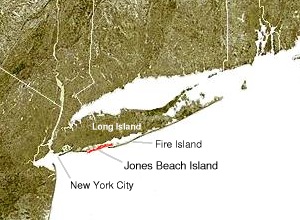Outer Barrier
| Part of a series on |
| Long Island |
|---|
 |
| Topics |
|
| Regions |
|
The Outer Barrier, also known as the Long Island and New York City barrier islands, refers to the string of
The lagoons enclosed by the barrier islands are
The islands

New York City islands
Long Beach Barrier Island
Long Beach Barrier Island lies off the
Within its section of the barrier island, the city of Long Beach spans the entire north-south width of the island, fronting on both Reynolds Channel to the north and the Atlantic Ocean to the south. A drawbridge, the Long Beach Bridge, connects it to Island Park, a small island which lies between Long Beach and the mainland of Long Island. To the west, the Atlantic Beach Bridge connects the island to Lawrence on Long Island. The Loop Parkway, located to the east where Lido Beach and Point Lookout border one another, connects the island to Jones Beach.

Jones Beach Island

Jones Beach Island is a barrier island off the southern coast of Long Island in the U.S. state of New York. It is named for the father of historian Thomas Jones. It is sometimes referred to as Oak Beach Island, and the former home of the infamous Oak Beach Inn. It is separated from Long Island by Great South Bay. The island straddles the county line between Nassau and Suffolk counties and includes the census-designated places of Gilgo, Oak Beach, and Captree.
The southern side of the island is known for its beaches that face the open Atlantic Ocean. Jones Beach State Park, on the western tip of the island is a summer recreational destination for the New York City area.

It is accessible from Long Island on its western end by the
Fire Island
Fire Island is a
There are several ocean front communities such as,

The inlet has evolved over the years due to natural processes, especially
Westhampton Island
Westhampton Island

Moriches Inlet is an inlet connecting Moriches Bay and the Atlantic Ocean. The inlet created a geographic oddity whereby the Town of Brookhaven actually has jurisdiction on land immediately west of the village of West Hampton Dunes although Brookhaven land access to it involves a nearly 20 mile drive through Southampton.
The inlet was formed by the
The inlet is almost directly lined up with the Shinnecock Canal between Shinnecock Bay and the Peconic Bay and saves miles for boaters going to the open Atlantic. Consequently, management has been geared to keep the inlet dredged and open. However, maintenance of the inlet has been controversial on grounds that it causes beach erosion on Fire Island.

See also

- Ocean Parkway (Long Island)
- Robert Moses Causeway
- Robert Moses State Park (Long Island)
- Rockaway Inlet
References
- ^ Cody, Sarah K.; Auwaerter, John; Curry, George W. (2009). "Cultural Landscape Report for Floyd Bennett Field" (PDF). nps.gov. State University of New York, College of Environmental Science and Forestry: 16.
- ^ "U.S. Census website". Retrieved March 29, 2020.
- ^ "GNIS Detail - Westhampton Island".
- ^ "ADCIRC Example, Shinnecock Inlet". www.nd.edu. Archived from the original on January 3, 2005.

